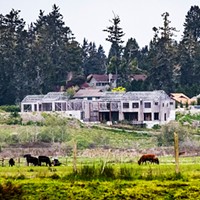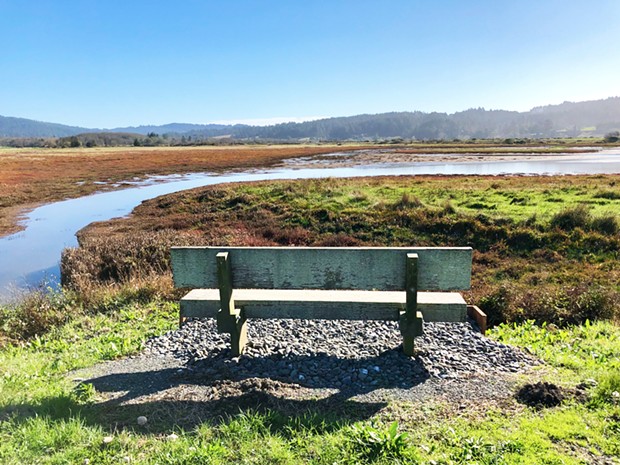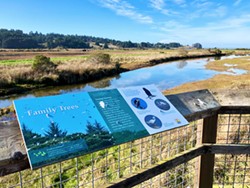[
{
"name": "Top Stories Video Pair",
"insertPoint": "7",
"component": "17087298",
"parentWrapperClass": "fdn-ads-inline-content-block",
"requiredCountToDisplay": "1"
}
]
When recovering after surgery, I was faced with a dilemma: Where to go for a gentle walk that was long enough without tempting me beyond limitations, yet interesting enough to keep hardened hikers happy, as well as amply benched for when the spirit was willing but the flesh needed to take a load off?
On a lovely November day, I found exactly what I needed at Humboldt Bay National Wildlife Refuge. At 1.7 miles, the Shorebird Loop Trail was long enough for a good walk, a flat, easy stroll for tender wounds. The wheelchair accessible loop has several wildlife viewing stations, including one spectacular location with an octagonal viewing platform.
Our adventure began when we passed the gate cautioning it would be locked at 5 p.m. To the left was a small parking lot with interpretive signs. The Aleutian geese that dotted this private field winter here, like many escaping the long grasp of a frozen winter. The state's largest eelgrass beds keep the geese well fed and a short grass pasture is groomed to help them flourish.
Back in the van, we followed Eel River Road to the Richard J. Guadagno Visitor Center, replete with ample solar panels. A whiteboard showed a list of recent wildlife sightings and that we'd just missed the 11 a.m. Wednesday guided tour. Just as well, as my speed was not yet up for group travel. We paused to take in the expansive view of Aleutians in the distance. The sun glinted in our faces. The ramp down to the path beckoned.
An interpretive panel reminded us the Wiyot people are the original stewards of Humboldt Bay, and their gentle use of the land was a stark contrast to mechanized farming.
The landscape's agricultural history left many irrigation channels and access roads still used to manage the wetlands, but clearly marked off-limits for hikers. Humans are not the target market of this Winter Hotel. Flooded in winter, dry in summer, the refuge caters to its patrons' every need, be they a winter wader or a summer ground nester. More than 10,000 Pacific Brant can check in on any given day from January through April, leaving as the seasonal beds are being remade for Summer Hotel arrivals. We happily follow the path, pausing at the first floodgate. I love a good bit of hydraulic engineering. Wandering off, we strolled between trees in glorious noonday sunlight. Delighted, we found a birdwatching station complete with Bird Sampler panel that suggests getting an identification and a good set of binoculars (embarrassingly left at home). I take a snapshot of the sign to tide us over.
I scanned ahead for a bench but it already held two lovely ladies who nodded hello as we passed. The strip of riparian forest thinned and delicate lichen dripped light green from autumn-bare branches. Velvet brown cattails shed tan fluff in the light breeze. There is fall color beyond the blaze of short-term deciduous glory. "Harrier! Harrier!" my spouse whispered as he pointed out the feathered blur of a raptor.
I inhaled, content to mosey, always looking for the next bench. Instead, I saw a lone duck dip underwater, searching the bottom of Salmon Creek as two egrets fished in the background. The duck popped up further along than I anticipated, wagging tail feathers as it floated away.
I barely noted passing over the next floodgate as an empty bench overlooking freshwater Long Pond appeared. I sat with a satisfied sigh. The handful of ducks scattered to the far reaches of the pond. At full capacity, the Winter Hotel can host up to a mind boggling 100,000 birds (turndown service not available).
Only 10 percent of Humboldt Bay's saltwater marshes are left, having been managed out of existence for the sake of freshwater agriculture. Like most U.S. Fish and Wildlife preserves, Humboldt Bay NWR started with farmers and agencies stitching together conservation easements and leases. The restoration started a long time ago, but climate change and rising sea levels continue to threaten these valuable wetlands.
Long Pond lives up to its name. We ambled along as the light breeze added ripples to the wake of the ducks. Without binoculars, they seemed to challenge us to identify them. Next time.
The Shorebird Loop looped, crossing over another floodgate. The gate stood guard, closed to protect the wetlands from incursions of seasonal high tides. After the danger passes, the gate will be opened to allow for the reconnection of freshwater creeks to the bay. The thin strips of land separating the freshwater and brackish marshes seemed so fragile. These dikes were created and maintained by dredging. A massive round scoop rested on the bank. Formerly the main tool of the dredge Jupiter, the bucket was vital in creating pasture for cattle and fields for grain. The changes it made in the estuary were seen as positive. Retired in the 1970s, the rusting hulk now bears witness to work that reverses its efforts.
The next bench overlooked brackish waters. Humboldt Bay has gnawed at the dike opposite, its rising tides undaunted by old earthworks. A change in sea level combined with greater king tides leaves it all at risk. We wandered along, stopping at the next panel to learn more about the salmon fry habitat in the aptly named Salmon Creek.
My partner pointed out a structure in the distance. Built of solid redwood, the octagonal viewing station has a curved ramp and tee-shaped bench to make any weary visitor happy. The expansive view took our breath away, and we giggled at the interpretive panels about feathers and flight that were dotted with guano. We stepped over an eaten wing at the top of the ramp, reminding the hotel is also a larder for hunters, two- and four-legged, as well as winged. The northern edge of the grounds is the realm of hunters looking for a goose or duck dinner.
People chatted as they passed, faces turned to the sun. We had come full circle and the bench that earlier held friends was now empty. A left fork gave us an opportunity to take in the last viewing station. We were charmed by a quiet backwater with cattails and scattered ducks that quacked their disdain at having their photo taken. An old barn stood testament to the hard graft of wresting a life from wet soil. Silver gray, its hulk took on a beauty of its own. A cacophony startled us as a great flock of Aleutian geese took off over the field. We glimpsed them through the trees as the living mass circled its domain.
Tired but not worn, happy and satisfied, we headed back to our vehicle. "Binoculars," he muttered as we passed through the parking lot.
"Binoculars," I agreed.
Meg Wall-Wild (she/her) is a freelance writer and photographer who loves her books, the dunes of Humboldt and her husband, not necessarily in that order. When not writing, she pursues adventure in her camper, Nellie Bly. Follow Meg on Instagram @megwallwild.
Speaking of...
-

'Our Food is Our Medicine'
Mar 28, 2024 -

Despite Coastal Commission Appeal, Schneider Mansion Demolition, Restoration Could be Complete by July
Jan 9, 2024 -

Humboldt Bay Timeline
Oct 12, 2023 - More »
more from the author
Latest in Get Out
Readers also liked…
-
A Walk Among the Spotted Owls
- Apr 27, 2023

































